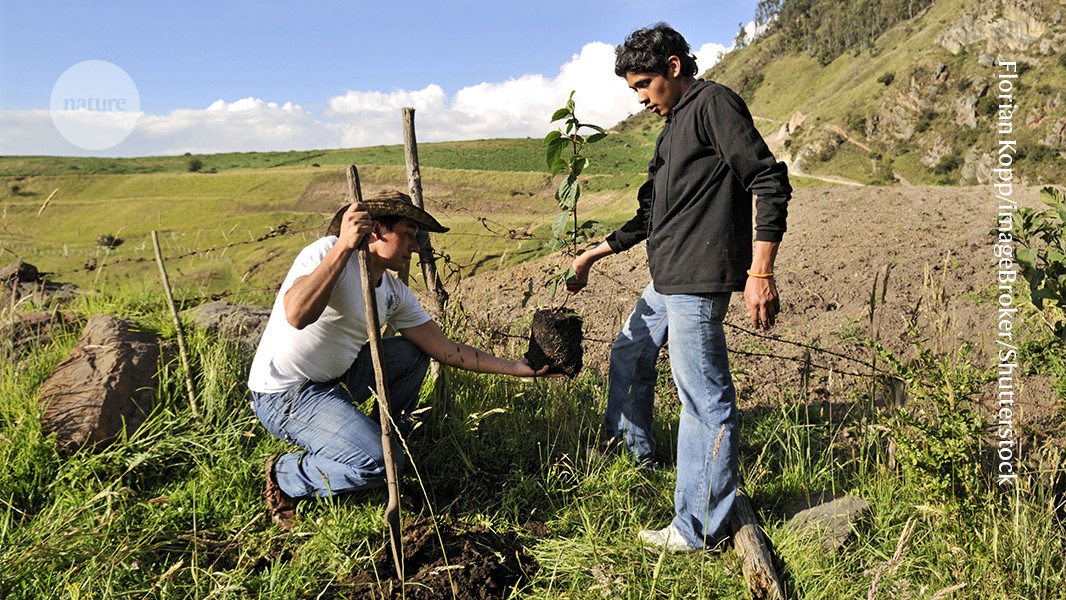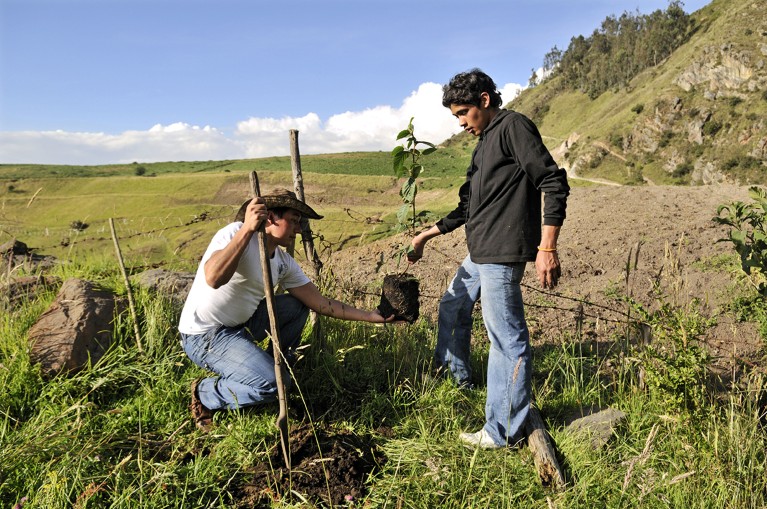
Workers plant trees in the outskirts of Bogotá as part of a reforestation project.Credit: Florian Kopp/imageBroker/Shutterstock
This year’s Global Risks Report from the World Economic Forum ranked ‘biodiversity loss and ecosystem collapse’ as one of the three most severe risks that societies face over the next ten years, alongside ‘extreme weather’ and ‘critical change to Earth systems’ caused by climate change1.
There is a plan to address this threat. In 2022, 196 countries adopted the Kunming–Montreal Global Biodiversity Framework, agreeing to halt and reverse biodiversity loss by 2030 and ensure that natural resources are used sustainably by 2050. Yet, an estimated funding gap of US$598 billion–$824 billion exists between current annual spending on conservation and restoration and what is needed to achieve the goals of the framework2. Public finance and policies can help to close this gap — for example, governments could lower taxes for green technologies and redirect subsidies from activities that are environmentally harmful to those that are more sustainable. But a new source of finance is also needed.
Biodiversity credits are one mechanism, highlighted by the Global Biodiversity Framework, that could help to generate private-sector funds and ensure that those funds pay for demonstrable conservation and restoration achievements. By buying these credits, which would be used to fund certain projects, companies could achieve any one of three goals. First, to boost their profile and marketing, organizations could make contributions to improving the world’s biodiversity independent of their own activities. Second, after assessing their impact on the environment and doing all they can to avoid or minimize harm, companies could compensate for any residual harm in a like-for-like way — meaning the credits they purchase would need to fund remediation efforts in the same location and ecosystem type as wherever the harm is being done3. Last, organizations could invest in efforts that enhance biodiversity and resilience in their supply chains.
Analysis: the biodiversity footprint of the University of Oxford
Some corporations are already making promises not just to minimize their impact on nature but also to enhance ecosystems and enrich biodiversity — in other words, to become ‘nature positive’. And mandatory biodiversity-credit markets (in which companies that are harming the environment are required by law to purchase credits) are emerging in several countries, including Colombia, Germany, India, France and England. But — as the failures of carbon-credit markets, designed to reduce greenhouse-gas emissions, have made plain — for biodiversity-credit markets to grow and achieve what’s needed, they must be built in the right way, and they must operate in the right way.
As members of the International Advisory Panel on Biodiversity Credits, we have been developing a road map for biodiversity credits for about a year. Our panel consists of scientists, Indigenous Peoples and representatives from local communities, non-governmental organizations (NGOs), finance and industry. Together, we have analysed 31 initiatives that are trialling the use of biodiversity credits in 21 countries. We have organized events at international meetings and held hundreds of discussions and numerous workshops in multiple languages. We have also conducted two global surveys to assess people’s interest and understanding, and to better understand how potential sellers and buyers imagine using biodiversity credits in practice.
Drawing on this work and taking lessons from other markets, including carbon-credit and finance markets, here we lay out what we think is needed to establish trustworthy, impactful biodiversity-credit markets. We will present our recommendations in full (which we have developed in collaboration with the World Economic Forum and the Biodiversity Credit Alliance, an international organization that aims to support the implementation of the Global Biodiversity Framework) at this month’s United Nations biodiversity summit COP16 in Cali, Colombia.
Carbon-credit conundrum
For most people working on issues tied to the environment, mentioning the word ‘credits’ brings to mind carbon credits. It probably also raises misgivings.
Carbon-credit markets generally involve carbon-offsetting projects, which promise reductions in emissions in one place (often through the planting of trees to absorb carbon dioxide, or through the protection of existing forests that act as carbon sinks) to compensate for the emission of CO2 in another location. Despite their promise in helping to reduce greenhouse-gas emissions, however, carbon-credit markets have hit problems4.
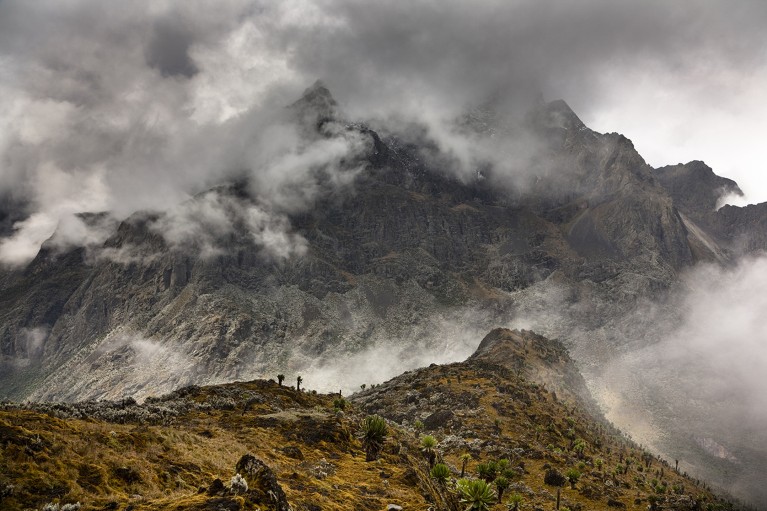
The non-profit organization Environmental Conservation Trust of Uganda is helping to restore forested land in the northern Albertine Rift in Uganda.Credit: Martin Zwick/Avalon
There has been a lack of transparency about how many offsetting projects have achieved or will achieve their long-term goals5,6, and a lack of clarity for buyers about how they can use the credits they purchase, and what claims they can make about them. Some schemes that focus only on the removal of CO2 from the atmosphere, such as the planting of eucalyptus trees in African savannahs, can harm biodiversity and the communities that depend on it. Because most projects have focused on forested ecosystems, other important carbon sinks, such as salt marshes, have been overlooked. It has been unclear how the costs and benefits of carbon-offset projects will be shared among those involved, and who gets to decide this. Also, few efforts have engaged Indigenous Peoples or local communities — or engaged them enough.
But carbon-credit markets are evolving and many of these problems could be resolved in the future. Also, well-designed biodiversity-credit markets — that help to strengthen the rights and voices of Indigenous Peoples and local communities — wouldn’t operate in the same way as today’s carbon-credit markets do. In fact, for biodiversity credits to drive the flow of money towards conservation and restoration that is needed — and for the work on the ground to be effective — governments and companies establishing biodiversity-credit markets must ensure that the problems that have arisen with carbon-credit markets are avoided. They will also need to ensure that the necessary conditions for biodiversity-credit markets to operate effectively are in place.
Carbon offsets aren’t helping the planet — four ways to fix them
Companies buying biodiversity credits should view them as a way to channel funds into long-term conservation and restoration initiatives, rather than as something they can quickly sell to another firm to make a profit — as can happen, for example, in cap-and-trade schemes in which a limited supply of carbon credits can make for valuable commodities in their own right. Also, one tonne of CO2 will have the same impact wherever it is released, whereas the effects of damage to biodiversity are hugely variable depending on the precise location. If a company negatively affects a rainforest in Borneo, for instance, any biodiversity credits that the company buys to compensate for that harm will need to fund equivalent conservation and restoration in the same ecosystem.
Five aspects in particular need addressing.
Measuring the state of nature. One of the most commonly asked questions in our discussions was, ‘How do you measure actual improvements to biodiversity (or the amount of biodiversity loss that will be avoided thanks to an initiative) in a consistent, reliable and credible way?’
Biodiversity is much more complicated to measure than are carbon emissions7. It encompasses genetic, taxonomic, functional, evolutionary and ecosystem diversity — all of which can be assessed in different ways8. For instance, when assessing taxonomic diversity, biologists might count the number of species in an area, or they might just count the number of genera. More than 570 biodiversity metrics have been proposed so far, and standards for monitoring biodiversity continue to be debated at international and national levels9. Also, how people value biodiversity will vary depending on the species or ecosystem in question, and the geographical and cultural context. Adding to these difficulties, the restoration of habitats can take decades, making it hard to measure a project’s actual or potential impact.
But a balance can be found between technical rigour and practicability.
Even relatively simple metrics, such as the probable impact of land-use changes on the risk of certain species going extinct (which can be readily estimated10), can provide clues about an ecosystem’s integrity and, crucially, about how this changes over time. And an array of metrics, such as the number of individuals in easily identifiable and ecologically important species groups, can be used to support assertions about improvements made to biodiversity and enable biologists to detect positive change in a relatively short time frame.
Through our consultations and analyses, we have identified six key criteria for biodiversity measurements and reporting standards. First, with the objectives and rights of Indigenous Peoples and local communities and of those buying the biodiversity credits in mind, a project’s goals — meaning what aspects of biodiversity are to be conserved or restored and to what degree — should be made clear at the outset. Second, measurements should be verifiable, appropriate for that ecosystem and based on robust science11. Third, measurements should be confirmed and assured by individuals or organizations working independently of the project. Fourth, all data should be made publicly available. Fifth, measurements should be made before the conservation or restoration work begins, while the project is under way, and after the project has been completed. Last, results should show that, thanks to the project, more biodiversity conservation or restoration is enabled than what would have happened anyway.
Driving up demand. Many of the people we consulted questioned why companies would want to buy biodiversity credits. Certainly, outside the mandatory schemes, such as those established in Colombia and England, few companies are buying them today12. This is because companies are unsure of what biodiversity credits are, what makes a biodiversity credit high quality and how biodiversity credits should be used13. Companies are also wary because it can take years for substantial benefits of conservation and restoration projects to be detected — which in turn affects what statements an organization can make about what their purchases of biodiversity credits are achieving.
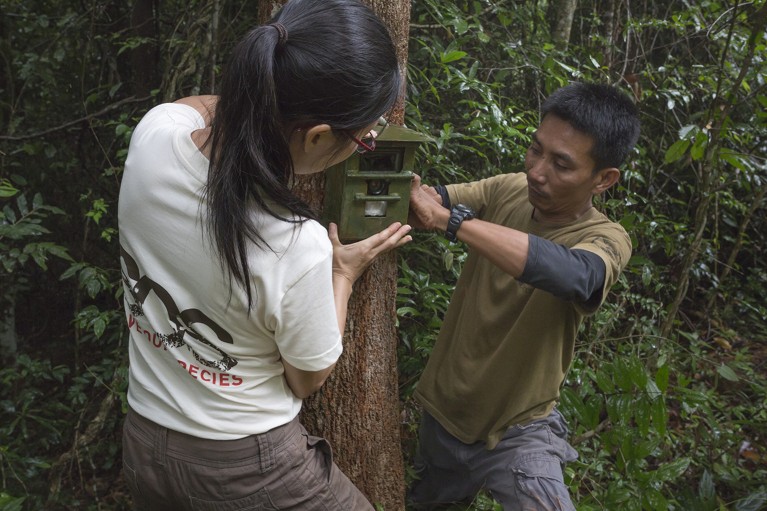
Technologies, such as camera traps, are making it easier to monitor changes to biodiversity.Credit: Ann & Steve Toon/Nature Picture Library
Yet, our discussions have convinced us that all sorts of organizations recognize humanity’s dependence on nature and are committed to addressing the biodiversity crisis as well as the climate crisis. Also, many of these obstacles listed can be tackled.
National and regional legislation should aid the development of ethical and trustworthy projects and transactions. This could entail requirements for companies to compensate for their harms to biodiversity. In February, the English government introduced a scheme called biodiversity net gain, a requirement that all new building projects achieve a 10% net gain in biodiversity (measured by the size, type, condition and strategic significance of the habitats being affected, on the basis of information such as species richness and rarity).
More governments should establish rules on what counts as like-for-like habitat and lay out what principles should underlie accepted methodologies and assertions — just as we are doing here. Also, more governments should provide publicly available lists of independently approved approaches that involve the use of biodiversity credits, and registries of conservation and restoration projects that need funding. Colombia’s government is doing exactly this in association with the environmental-investment company Terrasos in Bogotá.
Meanwhile, philanthropic organizations and impact-fund providers — which channel funds into investments that generate a measurable and beneficial social or environmental impact alongside a financial return — could provide the seed money needed to get projects up and running. This would in turn lower the risks of investment for private companies.
Stimulating supply. Most of the conservation and restoration projects being funded by biodiversity credits today are at an early stage, in which the suppliers of the credits (that is, those developing the conservation or restoration projects) are still refining their methodologies for measuring biodiversity, setting the prices of the credits, assessing demand, identifying buyers and so on.
To increase the number of biodiversity credits available for sale, governments, impact-fund providers and philanthropic organizations should invest in the people, training and technology needed for measuring, conserving and restoring biodiversity. In other words, seed investment from these organizations would help to bolster both the demand for and the supply of biodiversity credits.
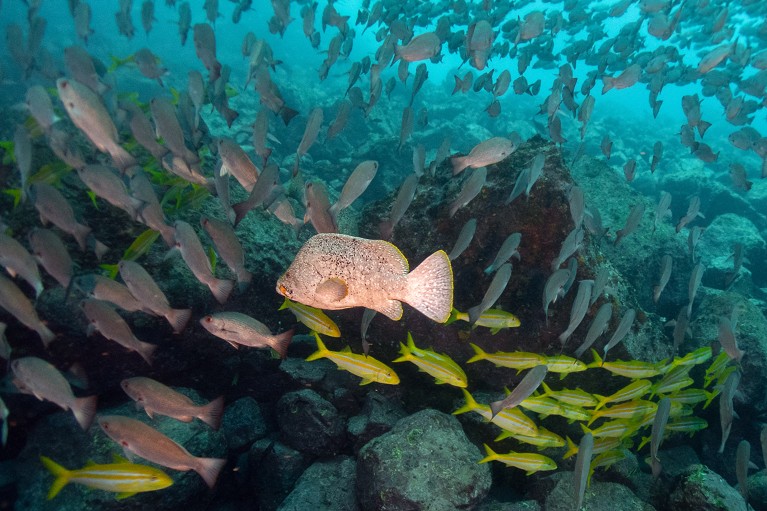
Environmentalists are trying to protect endangered marine species in the Colombian Pacific.Credit: Luis Acosta/AFP via Getty
Initially, the use of biodiversity credits will work better for some projects and regions than others. A current difficulty is the complexity of people’s rights to ownership of land, seas and natural resources. Such rights might not be officially registered, but might align with the customary laws, values and traditions of Indigenous Peoples or local communities. Also, the rules and customs around who owns what vary in and between countries, and in the case of international waters, multiple countries are involved in governance14. Longer term, these challenges can and must be addressed.
Setting the rules. The main lesson from carbon-credit markets is that governments should develop and enforce clear rules — about how biodiversity credits can be used, what needs to be reported by those selling them, what can be said about them and so on. Establishing and enforcing these rules will require governments and international oversight bodies to work together with organizations that set standards (such as those establishing certification schemes), Indigenous Peoples, local communities and international and national NGOs.
Governments should require, for example, project developers selling biodiversity credits to make project information publicly available — from the impact of projects on biodiversity to the benefits they provide to local communities. In principle, a new or existing body at the international level could support the development of ethical and trustworthy biodiversity markets by developing standards, and sharing information and lessons from biodiversity-credit funded projects.
Certification schemes could also help to ensure that biodiversity credits are ethical and trustworthy. Various media reports suggest that some certification systems have failed to protect either biodiversity or Indigenous Peoples. But emerging schemes are tackling these issues — such as the Global Biodiversity Standard for habitat restoration, which aims to provide assurance that tree planting, habitat restoration and agroforestry practices are protecting, restoring and enhancing biodiversity.
Making projects work on the ground. One of the most common criticisms that we have heard environmentalists and others make about carbon-offset projects is that those involved fail to sufficiently engage the local stewards and custodians of land and seas in the design, planning and running of projects.
In many carbon-offset projects, if Indigenous Peoples and local communities are considered at all, they are consulted only in the final stages of the project. Or they might be asked to sign forms to give their ‘free, prior and informed consent’. Such forms are a crucial tool. But in many cases, if they are given to people at all, they are given too late or without sufficient discussion. Also, often the forms are not legally binding.
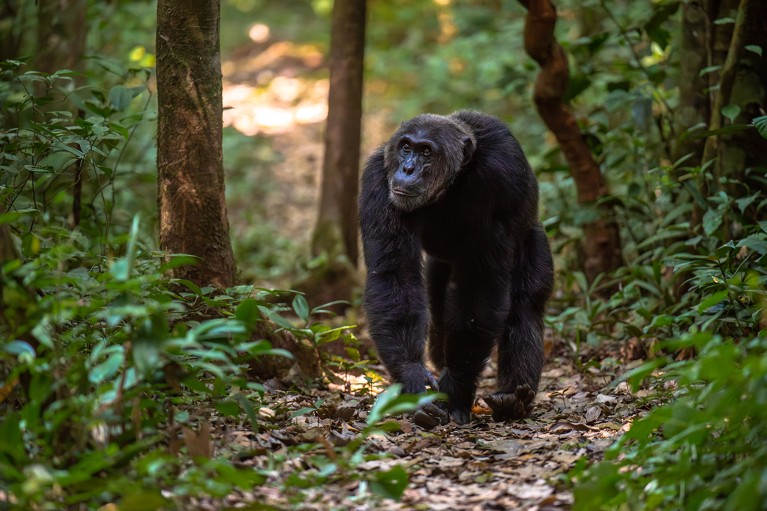
A project in Uganda is trialling the use of biodiversity credits to help the conservation of the chimpanzee.Credit: Godong/Universal Images Group via Getty
Formally recognizing the importance of Indigenous and local knowledge, and the rights of Indigenous Peoples and local communities to govern and manage their lands according to traditional practices, when designing biodiversity-credit markets would be a game-changer. Securing and protecting the rights of these communities is ultimately the duty of governments. Yet, to ensure that biodiversity-credit markets do not worsen current inequities, no biodiversity credits should be bought or sold without a seller first certifying to the buyer how people’s rights are being (or will be) observed and protected in the projects tied to the credits.
In practice, this means companies enabling Indigenous Peoples and local communities to drive projects forwards from the outset. It means ensuring that individuals get the conservation or restoration training they need; that Indigenous Peoples and local communities receive fair compensation for their stewardship of biodiversity; that benefit-sharing mechanisms are integrated into contracts and so on.
As an example, in one of the 31 projects that we have analysed, the non-profit Environmental Conservation Trust of Uganda is building on its 25 years of experience and working with nearly 42,000 smallholder farming households. Project goals include: restoring 12,000 hectares of forested land to provide connectivity for wildlife between currently protected but fragmented blocks of forest in the northern Albertine Rift in Uganda; supporting the conservation of several threatened species, such as the chimpanzee; and creating income opportunities for more than 15,000 households. Crucially, the project has been designed by rural communities, and it will be owned and led by them.
One year on
When we were invited to develop a road map for biodiversity credits in 2023, we recognized the importance of the task, but were also concerned about the risks. We knew about the problems with carbon offsets and we were daunted by the ecological, social, financial, ethical and legal challenges that biodiversity-credit markets present.
One year on, we still think that unregulated markets could lead to a poor use of public and private funds just when those funds are needed the most. These markets could even worsen the situation if investors are unable to recognize greenwashing claims; if companies use biodiversity credits to sustain or increase their negative impacts on biodiversity; and if efforts to protect and restore biodiversity fail to embrace the rights and needs of Indigenous Peoples and local communities.
But all of us that have worked on this project are now convinced that — designed in the right way and used alongside other approaches, including those using high-quality carbon credits or payments for ecosystem services15,16 — biodiversity-credit markets could become one of the most important funding sources for implementing the Global Biodiversity Framework.
Governments shape economies, champion innovation and enable markets through the signals they send and the rules they set. We therefore urge all governments to introduce policy measures and legislation that encourages — or preferably requires — companies to assess, disclose and address their impacts on biodiversity (as outlined in target 15 of the Global Biodiversity Framework). As part of this process, we recommend that the regulation, certification and enforcement of biodiversity credits be based on the framework laid out here and in our full report.
Over time, success will be measured, not so much by the total market value, but by the long-term benefits that such credits bring — to biodiversity and to people.


